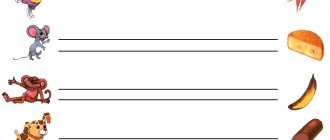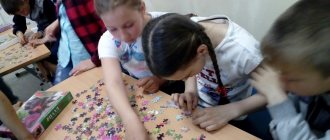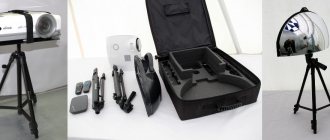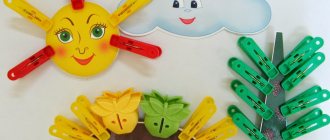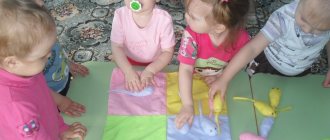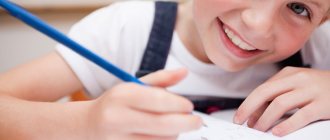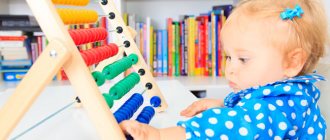The use of non-traditional materials in the development of fine motor skills in preschool children.
Topic: The use of non-traditional materials in the development of fine motor skills in preschool children.
The issue of developing fine motor skills in children in modern times is quite relevant. This is repeatedly emphasized by teachers, psychologists and other specialists in the field of preschool education. The relevance of work on the development of fine motor skills in young children is determined by the age-related psychological and physiological characteristics of children: in early and early preschool age, the structures and functions of the child’s brain intensively develop, which expands his capabilities in understanding the world around him. A person cannot develop a comprehensive understanding of the surrounding objective world without tactile-motor perception, since it underlies sensory cognition.
What are fine motor skills? It is a set of coordinated actions of the nervous, muscular and skeletal systems, often in combination with the visual system in making small and precise movements of the hands and fingers and toes. The area of fine motor skills includes many different movements: from primitive gestures, such as grasping objects, to very small movements, on which, for example, human handwriting depends.
The importance of fine motor skills is very important.
1. Hand movements are the basis for developing self-care skills in children.
2. The level of development of fine motor skills is one of the important indicators of a child’s readiness for school.
3. Movements of the fingers affect the development of the motor function of speech and stimulate the development of other mental functions - thinking, memory, attention.
The function of the human hand is unique and universal. Sukhomlinsky wrote in his memoirs that
“The origins of children’s abilities and talents are at their fingertips; from them, figuratively speaking, come the finest streams that feed the source of creative thought. The more confidence and ingenuity in the movements of a child’s hand, the more subtle the interaction of the hand with a tool (pen, pencil), the more complex the movements necessary for this interaction, the brighter the creative element of the child’s mind, the more skill in the child’s hand, the smarter the child.” .
V.A. Sukhomlinsky.
According to M.M. Koltsova, the level of speech development is directly dependent on the degree of formation of fine movements of the fingers: if the development of finger movements corresponds to the child’s age, then his speech development will be within normal limits; if the development of finger movements lags behind, the development of speech is also delayed. MM. Koltsova notes that there is every reason to consider the hand as an “organ of speech” - the same as the articulatory apparatus. From this point of view, the motor projection area of the hand can be
Introduction
Drawing introduces children to the world of beauty, develops creative abilities, forms aesthetic taste, and allows them to feel the harmony of the world around them.
All children love to draw. Creativity for them is a reflection of mental work. Drawing for a child is a joyful, inspired work that he should not be forced to do, but it is very important to stimulate and support the child, gradually opening up new opportunities for him. However, drawing with pencils, brushes and paints requires the child to have a high level of mastery of drawing techniques, developed skills in drawing objects and knowledge of drawing techniques, as well as techniques for working with various paints. Very often, the lack of this knowledge and skills quickly turns a child away from drawing, since the resulting drawing turns out to be unattractive and does not correspond to the child’s desire to get an image that is close to his idea or the real object that he was trying to depict. To successfully teach children to draw, you can use non-traditional techniques.
What are the benefits of non-traditional techniques? To work in many of them, mastery of familiar tools is not required - you don’t need brushes and pencils when you have your own fingers and palms, which the baby listens to much better than an artist’s tools. Original, unconventional drawing attracts with its simplicity and accessibility, revealing the possibility of using well-known objects as artistic materials. For work, you can use various materials and tools, since children’s imagination provides more and more opportunities for confident mastery of visual arts. To create a “mosaic” masterpiece, a sheet of well-crumpled paper is suitable. And even a fluffy fur coat will be given to the little bunny by a prickly paint brush from dad’s toolbox and cheap toothpaste. There are so many different ways for a little dreamer to express himself!
By acquiring appropriate experience in drawing in non-traditional techniques, and thus overcoming the fear of failure, the child will subsequently enjoy working with a brush and paints and will seamlessly move on to learning drawing techniques. And the main thing is that unconventional drawing plays an important role in the overall mental development of the child.
Children perceive art classes as a new, unusual and interesting experience. At first, they are of little interest in the result, but rather in the process itself. However, even very little ones are able to understand, appreciate beauty in their own way and are ready to create their own work of art.
Children's drawings attract with their spontaneity, unique expressiveness, and unexpectedness of images.
L. S. Vygotky says that “a child draws not what he sees, but what he knows,” “a child can do anything until he knows that he cannot do something.”
The drawing process also contains psychotherapeutic elements. The presence of an adult nearby makes the drawing process calming; Experiences spill out onto the sheet and the baby is freed from them. A “graphic response” occurs. At this moment, a drawing can become a means of visual communication between an adult and a child.
With skillful organization of classes taking into account age and individual characteristics, drawing can become one of the favorite activities, can become, and most often is, a sustainable hobby for almost all children.
Thus, the child gains experience in iso-activities:
• Learns to be original
• Learns to use means of expression
• Learns to evaluate one’s own and other people’s activities
• Learns to show initiative and independence
• Develops individuality using skills and abilities in the use of various techniques
Relevance of this problem
In the process of drawing, the child’s observation, aesthetic perception, artistic taste, and creative characteristics are improved. Children get acquainted with a variety of unconventional drawing methods, their features, the variety of materials used in drawing, and learn to create their own drawings based on the knowledge gained.
Thus, a creative personality develops, capable of applying their knowledge and skills in various situations.
The relevance is determined by the following problems:
1. Social and economic transformations in society dictate the need to form a creatively active personality with the ability to effectively and innovatively solve new life problems.
2. School learning requires a fairly developed level of imagination. By the first grade, a child should be able to navigate situations in which various transformations of objects, images, and signs occur, and be ready to anticipate possible changes.
3. Imagination is a prerequisite for children to effectively acquire new knowledge; no type of creative activity can do without imagination.
4. Imagination largely determines the effectiveness of educational activities in preschool educational institutions.
The use of non-traditional techniques in drawing by children is relevant and significant in practical and theoretical terms.
Research by Russian teachers and psychologists E. A. Flerina, N. G. Sakulina, E. I. Ignatieva and others gives reason to conclude that drawing is an integral part of a child’s development.
The development of creative abilities of preschool children is given sufficient attention in comprehensive educational programs. One of them is the “Development” program, developed by the Training Center of L. A. Wenger, O. M. Dyachenko and others, which we use in our practice of working with preschoolers. The authors of the program propose to introduce children to traditional methods of drawing through the implementation of the tasks of the “Fine Arts” section. The content of this program has no variability; there is uniformity in the program content of the GCD, as well as consistency in the use of artistic means. This limits the opportunity to actively develop children’s creative abilities and the ability to think unconventionally, and creates a certain pattern of activity. Modern society requires creatively active individuals who have the ability to effectively and innovatively solve new life problems.
To fully implement tasks at the present stage, it is necessary to identify and use new effective forms of joint activity in working with children that contribute to the formation of a creative personality in modern conditions.
In this regard, the use of non-traditional visual techniques, in our opinion, can act as one of the important means of developing the creative abilities of our students.
The results of the work should be:
— Children’s activity and independence in drawing
— Ability to find new ways for artistic depiction
— The ability to convey your feelings in your work using various means of expression.
The purpose and objectives of this work
The goal of our work was to develop the creative abilities of preschoolers through the use of non-traditional visual arts techniques.
It was planned to achieve the goal through the implementation of the following tasks:
1. Create conditions in the group for organizing creative activities using non-traditional techniques
2. Introduce children to new methods for artistic depiction
3. Develop the ability to convey your feelings in your work using various means of expression
4. Organize interaction with parents of students on the development of children’s creative abilities through the use of non-traditional techniques of visual arts
Pedagogical principles
We built our work in compliance with the following didactic principles:
• The principle of accessibility, the education and upbringing of a child is carried out in an accessible, attractive and age-appropriate manner; a transition from simple to complex tasks is provided.
• The principle of humanism - assumes an individual - indicative approach and all-round development of the child.
• The principle of connection with life experience. The image should be based on the impression the child receives from reality. The specific result, success and quality of a child’s education depends on the skillful implementation of this principle.
• The principle of clarity is expressed in the fact that children have a more developed visual-figurative memory, so thinking is based on perception and representation. Taking into account the psychology and age characteristics of young children, visualization plays a big role in combination with words.
• The principle of phasing. Sequence: When starting the next stage, you cannot skip the previous one.
• Principle of integration. Various areas of educational work and types of children's activities. It is implemented through the organization of various forms of activity: joint activity of the teacher with children, independent activity of children, interaction with the family.
• Scientific principle. Children gain knowledge about shape, color, composition, etc.
Teaching methods and techniques
In our work we use various methods and techniques:
— visualization method (examination of illustrations, albums, postcards, tables, videos and other visual aids);
- the gaming method (this is the playing out of objects, completed drawings, unfinished images, the spontaneous emergence of images, the use of educational games). The use of gaming techniques, fairy-tale images, and surprise effects helps to interest the child and set him up for creativity;
— examination method (ensures children’s independent creative exploration by means of expressiveness);
- problem presentation method (stimulates children’s activity by including a problem situation in the course of the lesson. The method is aimed at activating creative thinking, rethinking generally accepted patterns and searching for non-standard solutions.) - partial search method is aimed at developing cognitive activity and independence. It consists of performing small tasks, the solution of which requires independent activity (working with diagrams, using imagination and memory).
— co-creation method (creation of collective works, exhibitions united by a common theme);
- informational-receptive (examination, observation, sample and demonstration by an adult);
— the heuristic method is aimed at demonstrating independence at some point in the work, that is, we invite the child to do part of the work on his own;
— the research method is aimed at developing in children not only independence, but also imagination and creativity;
Our work is based on the idea of learning without coercion, based on the child's sincere interest in completing the task. This gives the child confidence in his abilities and puts him in the position of a creator. By creating conditions that encourage the child to study, it is possible to reveal these creative inclinations that have been dormant for the time being. New approaches liberate the child. He is no longer afraid that something will not work out for him - a little technique, and a spot on a sheet of paper turns into a cat, a mighty tree, a sea monster. It is easier for a child to place a spot on a sheet of paper, make strokes, and work with a brush in all directions, freely coordinating hand movements.
Organization of a developing subject-spatial environment
The group has created a subject-based development environment, which is based on the principles highlighted in our work. The art activity corner is equipped with a variety of visual materials, and visual and informational material has been selected. Conditions have been created for creative experimentation with visual materials, tools and drawing methods. To systematize the work, we also produced and placed in the functional room “Art Studio” didactic games, which also contribute to the development of children’s creative abilities. We use them in joint and independent work with children to implement the tasks of the educational field “Artistic Creativity”.
The developmental environment plays an important role in the development of the child, therefore, when organizing the subject-developmental environment, we took into account that the content was developmental in nature, and was aimed at developing the creativity of each child in accordance with his individual capabilities, was accessible and appropriate to the age characteristics of children. Parents took an active part in equipping the subject-development environment. There are so many unnecessary interesting things at home (toothbrush, combs, foam rubber, corks, polystyrene foam, spool of thread, candles, etc.). We went out for a walk, took a closer look, and saw how many interesting things there were: sticks, cones, leaves, pebbles, plant seeds, dandelion and poplar fluff. All these items can enrich the corner of productive activity. Unusual materials and original techniques attract children because the word “No” is not present here, you can draw with whatever you want and how you want, and you can even come up with your own unusual technique. Children feel unforgettable, positive emotions, and by emotions one can judge the child’s mood, what makes him happy, what makes him sad.
Organization of activities with children
In our work we used:
- comprehensive classes - expanding knowledge about the world around us, aesthetic perception, interest in nature, improving drawing techniques, developing fine motor skills of the fingers.
- combined classes - traditional and non-traditional techniques are used.
- collective and individual forms of work: children enjoy collective activities, joint activities to create one common drawing, special satisfaction comes from the overall result, which in this case is always richer in content and makes a more vivid impression than individually completed work. Children understand that together they can create a more significant image than each individual. In the process of collective activities, favorable conditions are created for children to communicate with each other and with the teacher, and upon completion of the work, the children rejoice at the results of joint activities - the same feelings unite them. Group images can be organized in different age groups.
— for independent activities, we try to prepare beautiful and varied materials, giving children the opportunity to choose visual media. An unusual start to work, the use of gaming techniques - all this helps prevent monotony and boredom in children's visual activities, and ensures the liveliness and spontaneity of children's perception and activity. In many ways, the result of a child’s work depends on his interest, so in joint activities it is important to intensify the preschooler’s attention and motivate him to activity with the help of additional incentives.
The child’s creative activity will become even more successful if the teacher evaluates it positively, not comparing the children’s work with each other, but noting the individual manner of performance. Therefore, we pay special attention to the discussion of children’s works, and we make sure to introduce into practice the analysis of a child’s work in an individual conversation with him. At the same time, we try to evaluate the child’s achievements in accordance with his own previous ones, thoroughly justify the assessment and give it a positive character in order to open the way to correcting mistakes.
By developing interest in activities, we try to provide children with as much independence as possible and help them complete their assigned tasks. In this case, we do not set the task of accurately repeating the sample, but with its help we strive to arouse in the child the desire to create, change, improve.
I developed the notes taking into account the age characteristics of the children, relying on the existing skills and abilities in the artistic and productive activities of preschoolers, adhering to an approximate plan:
- creating a gaming situation to attract children’s attention and develop emotional responsiveness (riddles, songs, nursery rhymes; a fairy-tale character in need of help, dramatization games, exercises to develop memory, attention and thinking; outdoor play);
- image of an object (examining and feeling the object, in some cases showing image techniques);
- finalizing the drawing with additional elements (you need to draw children’s attention to means of expression - correctly selected colors, interesting details); — examination of the work received (children’s drawings are given only a positive assessment; children should be happy with the result obtained and learn to evaluate their work).
Working with parents
In order to interest parents in their work, the group regularly organizes exhibitions of children's work, the purpose of which is to demonstrate the children's achievements. Consultations are held at which we tell parents how to draw using non-traditional techniques, and for a deeper understanding we provide them with reminders about non-traditional drawing techniques. We also organize seminars and workshops for parents, where we introduce parents not only to the theoretical foundations of non-traditional drawing techniques, but also take an active part in master classes in order to improve their competence.
The parents of the students became interested in our work. Many of them have become active participants in the pedagogical process: they participate in the creation of joint exhibitions, find original ideas for creativity and willingly share them with the group’s teachers. Parents participate in the design of the subject-development environment, making drawing materials with their own hands (pokes, drawing objects from waste material, etc.). Many parents began to treat children's creative products with more care and interest and display them at home.
An indicator of the increased level of parental interest in this issue is the fact that children more often began to study at home with their parents. They bring interesting works and show them to teachers and peers. Which is undoubtedly also an excellent means of developing their initial key competencies.
Conclusion
The relevance and effectiveness of pedagogical experience in developing the creative abilities of children of early and early preschool age through non-traditional drawing techniques is expressed in new approaches that liberate the child. He is no longer afraid that something will not work out for him. The artistic image obtained using non-traditional techniques turns out to be expressive. The child is satisfied with his result, and, therefore, gets involved in his own creativity.
The development of children's initiative and independence was facilitated by the conditions we created in the art studio for organizing creative activities using non-traditional techniques. This contributed
more successful introduction of children to new methods of artistic representation. We formed and consolidated children’s skills to convey their feelings in their work using various means of expression.
Systematic mastery of all necessary means and methods of activity provides children with the joy of creativity and their all-round development (aesthetic, intellectual, moral-labor, physical).
We can say with confidence that a variety of techniques contributes to the expressiveness of images in children's works, and also contributes to the manifestation of initiative and independence in children. Our work experience has shown that familiarization with image techniques brings true joy to children. Children boldly take on art materials; they are not afraid of diversity and the prospect of independent choice. They take great pleasure in the process of doing it. Children are ready to perform this or that action repeatedly. And the better the movement is, the more pleasure they repeat it, demonstrating their success.
Literature
1. Alekseevskaya N. “Mischievous pencil” Moscow, List, 1998
2. Wenger L. A., Wenger N. B., Pilyugina E. G. “Education of a child’s sensory culture”
3. Vygotsky L. S. “Imagination and creativity in childhood”
4. Gudilina S.I. “Miracles with your own hands”, Moscow, Aquarium, 1998
5. Doronova T. N. “Teaching children visual arts” Moscow, School - Press, 2005
6. Doronova T. N. “Nature, art and visual activities of children”
7. Doronova T. N., Yakobson S. G. “Teaching children 2 – 4 years old to draw in the game”, Moscow, Education, 1992
8. Zimina M. “Learning to sculpt and draw (from simple to complex)
9. Kazakova R. G. “Drawing with preschool children” (non-traditional techniques)
10. Kazakova T. G. “Visual activities of younger preschoolers”
11. Kazakova T. G. “Children’s fine arts”
12. Komarova T. S. “Fine creativity in kindergarten”
13. Koptseva T. A. Methodological recommendations for the program “Nature and the Artist” Moscow, 1994
14. Koptseva T. A. Program “Nature and the Artist”, Moscow, 1994
15. Lopatina A., Skreptsova M. “Colors tell tales” Moscow, Amrita - Rus', 2004
16. Lykova I. A. teaching aids by age for the “Colored Palms” program, Moscow, Karapuz - Didactics,
17. Lykova I. A. “Program of artistic education, training and development of children 2 – 7 years old “Colored palms””
18. “Methods of teaching visual activities”, ed. Komarova T. S., Moscow, Education, 1992
19. “Colorful songs: creative and aesthetic development of preschool children in the process of visual activity” Pskov Free Institute website
20. “Sensorimotor development of preschool children in fine arts classes” scientific supervisor Bezrukikh M. M.
Generalization
The topic of my work experience is “Development of fine motor skills in preschool educational institutions through non-traditional drawing techniques”
Developing the qualities of a creative personality in our children is one of the most important tasks of a modern preschool educational institution. Creating together with children and respecting children’s decisions is the main task of parents and teachers. Preschool age is a favorable period for the development of creativity. It is at this time that progressive changes take place in many areas, mental processes are improved (attention, memory, perception, thinking, speech, imagination, personal qualities are actively developing, and on their basis - abilities and inclinations. The more diverse children's activities, the more successful they are. comprehensive development of the child’s personality, his potential capabilities and first manifestations of creativity are realized.
In my opinion, visual arts are the most interesting activity for preschoolers. It allows the child to express his impressions of the world around him in his drawings. At the same time, the most accessible type of work with children is visual activity, artistic and productive activity, which creates conditions for involving the child in his own creativity and is invaluable for the comprehensive development of children, the disclosure and enrichment of his creative abilities.
While working, I encountered a problem - children are afraid to draw, because, as it seems to them, they don’t know how, and they won’t succeed.
This is especially noticeable in the speech therapy group, where children’s visual skills are still poorly developed, children lack self-confidence, imagination, and independence. As a rule, classes are often reduced to only a standard set of visual materials, non-traditional image techniques are rarely used, and their corrective significance is not taken into account.
As practice shows, it is obvious that traditional approaches to solving the problem of developing creative abilities, taking into account the potential of the new generation, this is not enough to develop creative abilities to express their fantasies. Meanwhile, the use of non-traditional techniques helps to enrich children’s knowledge and ideas about objects and their use; materials, their properties, ways of working with them.
After analyzing the drawings of my students, I came to the conclusion that it is necessary to facilitate drawing skills, this can greatly increase the interest of preschoolers in drawing. I believe it is necessary to fill the modern educational process with new content, principles, and methodological ideas aimed at developing creative aspiration, initiative, interest, and inspiration. It is important that the more actively a child’s creative abilities manifest themselves and develop in the educational process, the more active and successful his life position will be in the future.
I have formulated for myself the stages of work in this area:
I. Preparatory stage:
Analysis of psychological, pedagogical and methodological literature on the development of creative abilities of preschool children through non-traditional forms of visual activity
Organization and replenishment of the development environment;
Carrying out diagnostics of the development of creative abilities of preschool children;
Selection and systematization of forms of organization of children, methods and techniques that contribute to the development of children's creative abilities.
Development of a long-term plan for visual arts.
Drawing up a plan for interaction with parents and teachers.
II. Main stage:
Implementation of planned activities with children (direct educational activities, joint activities);
Interaction with parents and teachers.
III. The final stage:
Diagnostics, registration and analysis of results, summing up, forecasting further activities.
Having studied and analyzed the author's developments, teaching aids, such as: I. A. Lykova “Visual activities in kindergarten”, T. S. Komarova “Art activities in kindergarten”; G. N. Davydova “Non-traditional drawing techniques in kindergarten” and others, as well as the advanced experience of working with children accumulated at the present stage by practicing teachers, I became interested in the possibility of using non-traditional art techniques. activities in working with preschoolers. So, I found a lot of interesting ideas and techniques, and set a goal for my work, which would be the following: the development of fine motor skills in preschool children through non-traditional drawing techniques, the development of the creative abilities of preschoolers through the use of traditional and non-traditional techniques of productive artistic activity.
To achieve this goal, I put forward the following tasks:
1. Teach children non-traditional drawing techniques, combining various materials and image techniques, independently determine the idea, methods and forms of its implementation, technically competently use non-traditional and traditional methods of drawing, understand the significance of their work, experience joy and pleasure from creative work.
2. Develop children's creativity, visual - imaginative thinking, creative imagination and artistic taste, the ability to navigate on a sheet of paper.
3. To cultivate in children an aesthetic attitude towards the world around them through the ability to understand and create artistic images.
4. Create favorable psychological and pedagogical conditions in the group for the creative self-realization of each child.
5. The relationship between direct educational activities and children’s independent and joint activities with the teacher.
6. Involve in creative experimentation with visual materials, the use of methods for creating images on one’s own initiative and in new conditions, the use of a variety of visual techniques and their combinations;
7. Foster confidence, independence, initiative in productive artistic activity;
8. Involve parents in joint creative activities, increase their pedagogical competence in the field of artistic and aesthetic development of children.
Developing the creative abilities of a preschooler is the task of an adult. This means that the management of visual activities requires the teacher to know what creativity in general, and especially children’s, is, knowledge of its specifics, the ability to subtly, tactfully supporting the child’s initiative and independence, to facilitate the acquisition of necessary skills.
It is also important to create conditions for the artistic and aesthetic development of children, since the development of a child depends on how the process of his upbringing is carried out, how the space in which he grows and improves is organized, what kind of environment he is in - diverse, rich, extraordinary, changing.
Activity in various types of activities: the environment in a preschool institution, in comparison with a regular family environment, should be intensively developing, stimulating the emergence and development of the child’s cognitive interests, his volitional qualities, emotions, feelings. Creation of a subject-spatial development environment: for this purpose, we, together with parents, have created favorable conditions for children, an “Art Studio”, in order to satisfy the child’s natural desire for creativity, as well as the presence of a subject-development environment for productive artistic and creative activity:
Colored chalk, plasticine, sets of paints, markers, pencils;
Sets with stencils for applique and drawing;
Colored and white paper, cardboard, wallpaper, paper of different tones and textures;
Stickers, fabrics, self-adhesive film;
Paste, glue - pencil, cups for water, napkins for brushes; Board, easel, magnetic board;
Non-standard equipment (pokes, blowing tubes, cotton swabs, stamps, brushes, foam rubber, seals, cliches, etc.);
Educational games, albums for introducing arts and crafts, types and genres of art);
Coloring books, illustrative material, etc.
It is imperative to use gaming techniques, fairy-tale images, the effect of surprise, and, of course, one should not forget about the availability of a variety of materials for creativity and the ability to act with them at any moment. All this helps to interest the child and set him up for creative activity.
The success of teaching non-traditional techniques largely depends on what methods and techniques the teacher uses. To develop children's creativity, the following teaching methods can be used:
1) information-receptive method, which includes techniques for examining and showing a teacher’s model; 2) reproductive method aimed at consolidating the knowledge and skills of children. This is a method of exercise that brings skills to automaticity. It includes the technique of repetition, working on drafts, performing form-building movements with the hand; 3) a heuristic method, which is aimed at demonstrating independence at some point in the work during the lesson, i.e. the teacher invites the child to complete part of the work independently;
4) a research method that develops in children not only independence, but also imagination and creativity. The teacher offers to do not just any part, but all the work independently.
Artistic creativity is one of children's favorite activities. One of the techniques aimed at creating conditions for a child’s creative self-expression is organizing work with children using non-traditional drawing methods. To develop creative abilities in the classroom, I introduced the children to a variety of unconventional drawing techniques and began to teach the children this step by step from simple ones and gradually moving on to more complex ones. Each of these techniques is a little game.
The creative process is a real miracle; children reveal their unique abilities and experience joy; they get great pleasure from the very process of execution that creation gives them.
The experience of my work has shown that there are many techniques for mastering non-traditional image techniques that bring true joy to preschoolers if it is built taking into account the specifics of the activity and age of the children. It is non-traditional drawing techniques that create an atmosphere of ease, openness, promote the development of initiative, independence, and create an emotionally favorable attitude towards activities in children. In many ways, the result of a child’s work depends on his interest, so during the lesson it is important to intensify the preschooler’s attention and motivate him to activity with the help of additional incentives. Such incentives could be:
play, which is the main activity of children;
a surprise moment - a favorite fairy tale or cartoon character comes to visit and invites the child to go on a trip;
asking for help, because children will never refuse to help the weak, it is important for them to feel significant; musical accompaniment, etc.
In addition, it is advisable to vividly and emotionally explain to the children the methods of action and show depiction techniques.
Their use allowed children to feel:
1) more relaxed, bolder, more spontaneous;
2) develops imagination, spatial thinking;
3) gives complete freedom for development to freely express your plan;
4) encourages children to creative searches and solutions;
5) manifestation of initiative and individuality.
I noticed that the non-traditional drawing technique does not allow copying a model, the child experiences a variety of feelings: he is happy about the beautiful image that he created himself, he is upset if something doesn’t work out.
But the most important thing is that by creating an image, the child acquires various knowledge, his ideas about the environment are clarified and deepened, in the process of work he comprehends the new qualities of objects, masters skills, abilities, new non-traditional techniques, and learns to consciously use them. And the main thing is that unconventional drawing plays an important role in the overall mental development of the child. After all, what is intrinsically valuable is not the final product - a drawing, but the development of personality: the formation of self-confidence in one’s abilities, self-identification in creative work, purposefulness of activity.
I believe that on the one hand, teachers improve their creative abilities by accumulating theoretical and practical experience in solving problems, on the other hand, by working directly with preschoolers, they improve knowledge and deepen abilities in the process of co-creation. The main thing for a teacher is to remember a number of rules: encourage the child’s independent thoughts and actions if they do not cause obvious harm to others; do not interfere with the child’s desire to do or depict something in his own way; respect the student’s point of view, whatever it may be. Therefore, invite children to do more free drawings, verbal, sound, tactile and taste images, interesting movements and other spontaneous creative manifestations during classes and free activities of children.

